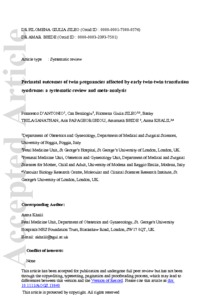D'Antonio, F; Benlioglu, C; Sileo, FG; Thilaganathan, B; Papageorghiou, A; Bhide, A; Khalil, A
(2020)
Perinatal outcomes of twin pregnancies affected by early twin‐twin transfusion syndrome: A systematic review and meta‐analysis.
Acta Obstet Gynecol Scand, 99 (9).
pp. 1121-1134.
ISSN 1600-0412
https://doi.org/10.1111/aogs.13840
SGUL Authors: Khalil, Asma
![[img]](https://openaccess.sgul.ac.uk/111783/1.hassmallThumbnailVersion/D%27Antonio_et_al-2020-Acta_Obstetricia_et_Gynecologica_Scandinavica.pdf)  Preview |
|
PDF
Accepted Version
Available under License ["licenses_description_publisher" not defined].
Download (14MB)
| Preview
|
Abstract
Introduction
Twin‐to‐twin transfusion syndrome (TTTS) is associated with a high risk of perinatal mortality and morbidity if not treated. However, the optimal timing and management in case of early (occurring < 18 weeks) TTTS has not been established yet.
Material and methods
This is a systematic review and meta‐analysis aiming at evaluating the outcomes of monochorionic diamniotic twin pregnancies complicated by early (ie before 18 weeks) TTTS according to different management options (expectant, laser therapy, amnioreduction or cord occlusion). The primary outcome was mortality, including single and double intrauterine, neonatal and perinatal death. Secondary outcomes were: composite morbidity, neuromorbidity, respiratory distress syndrome, admission to neonatal intensive care unit, intact survival (defined as survival free from neurological complications) and preterm birth < 32 weeks of gestation. All outcomes were reviewed according to the different management options (expectant, laser therapy, amnioreduction or cord occlusion) and reported FOR the overall population of twins, and for the donor and recipient separately. Subgroup analysis for TTTS occurring before 16 weeks of gestation was performed. Random‐effect meta‐analyses of proportions were used to analyse the data.
Results
Thirteen studies were included. Early TTTS occurred in 14.3% (95% confidence interval [CI] 11.9‐17.0) of cases. The incidence of intrauterine death was 19.0% (95% CI 2.6‐45.5) in twins managed expectantly, 32.4% (95% CI 16.5‐50.7) in those who received laser treatment and 12.5% (95% CI 4.8‐23.0) in those treated with amnioreduction. The incidence of neonatal death was 22.6% (95% CI 4.2‐49.8) in twins managed expectantly, 24.7% (95% CI 0.5‐80.3) in those who received laser and 20.2 (95% CI 5.8‐43.4) in those who had amnioreduction; it was not possible to compute the incidence of these outcomes in twins undergoing cord occlusion because of insufficient sample and lack of reporting of most of the observed outcomes. Overall, the incidence of perinatal death was 43.9% (95% CI 5.9‐87.7) in twins managed expectantly, 47.3% (95% CI 21.4‐70.0) in those treated with laser and 28.5% in those who had amnioreduction.
Conclusions
Twin pregnancies affected by early TTTS are at substantial risk of perinatal mortality and morbidity; however, the data come from very small studies with a high risk of selection bias.
| Item Type: |
Article
|
| Additional Information: |
This is the peer reviewed version of the following article: D’Antonio, F, Benlioglu, C, Sileo, FG, et al. Perinatal outcomes of twin pregnancies affected by early twin‐twin transfusion syndrome: A systematic review and meta‐analysis. Acta Obstet Gynecol Scand. 2020; 99: 1121– 1134, which has been published in final form at https://doi.org/10.1111/aogs.13840. This article may be used for non-commercial purposes in accordance with Wiley Terms and Conditions for Use of Self-Archived Versions. |
| Keywords: |
cord occlusion, laser, meta-analysis, monochorionic, systematic review, twin-twin transfusion syndrome, twins, Obstetrics & Reproductive Medicine, 1114 Paediatrics and Reproductive Medicine, 1117 Public Health and Health Services |
| SGUL Research Institute / Research Centre: |
Academic Structure > Molecular and Clinical Sciences Research Institute (MCS) |
| Journal or Publication Title: |
Acta Obstet Gynecol Scand |
| ISSN: |
1600-0412 |
| Language: |
eng |
| Publisher License: |
Publisher's own licence |
| PubMed ID: |
32162305 |
| Dates: |
| Date |
Event |
| 2020-08-18 |
Published |
| 2020-04-07 |
Published Online |
| 2020-03-08 |
Accepted |
|
 |
Go to PubMed abstract |
| URI: |
https://openaccess.sgul.ac.uk/id/eprint/111783 |
| Publisher's version: |
https://doi.org/10.1111/aogs.13840 |
Statistics
Item downloaded times since 16 Mar 2020.
Actions (login required)
 |
Edit Item |



